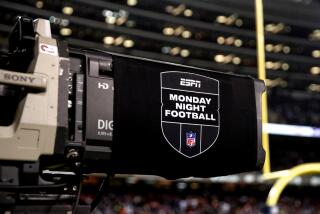Cable Offerings Planned to Compete With Video Shops
- Share via
LAS VEGAS — A number of companies that deliver movies to homes on cable TV are betting that Americans will pay extra for the convenience of not having to drive to the video store.
One of the prime topics at the National Cable Television Assn. convention here was pay-per-view, a system that takes advantage of computer technology to deliver a prizefight, a blockbuster movie or an erotic film by cable to only the people who order it.
Showtime-The Movie Channel, which already uses cable to deliver movies into the home on a monthly subscription basis, announced at the convention a plan to telecast recently released theatrical films, concerts and other popular special events on a pay-per-view basis.
Another entrant is Playboy Enterprises.
The company’s president, Christie Hefner, said she will suggest that cable system operators charge $3 to $4 to watch a three-hour Playboy show, which would include a 90-minute adult feature film.
She said she did not think the pay-per-view offerings will cut into earnings from the Playboy Channel subscription service, comparing it to the difference between a magazine subscription and newsstand sales.
“Those who don’t want Playboy programs on a subscription basis will buy occasionally on a pay-per-view basis,” she said.
Showtime expects to price its showings at about $4.50 per event. That compares with a national average of $3.15 to rent a video cassette, a figure that includes annual membership fees and late charges.
Officials of Showtime argued that the extra expense will be worth it because consumers will avoid the disappointment of going to the video rental store only to find the desired movie has already been checked out.
However, Playboy and Showtime will offer only one title a week, compared to the hundreds of titles available in a video store.
“Pay-per-view is a hits business,” a Showtime executive said, adding that he hopes that the Hollywood studios will release a film to the pay-TV market before allowing its distribution to video stores.
Pay-per-view is made possible by a new generation of cable converters that can be turned off and on by the local cable company.
A customer wanting to see a show would dial a special number, then give the order to an operator or use the push-buttons on the phone to enter some coding information, such as the customer’s name and the name of the show, and a computer will let the signal for that show pass into the consumer’s home.
Telephone companies are installing special equipment to handle any surge of phone calls from impulse buyers who might all call in a short period of time.
It is expected that the telephone companies will charge the consumer a special fee to call the ordering number to offset the cost of the new telephone equipment.
Will it work?
“The jury is still out on whether pay-per-view will take hold,” John C. Malone, president of Tele-Communications Inc. of Englewood, Colo., told the National Cable Television Assn. meeting.
A key element will be how fast the addressable converters are installed. One current estimate says there are about 7 million addressable households now, projected to grow to 26 million by 1990.
Cable companies that cannot decide if they think pay-per-view will beat videocassette rentals or who do not have the addressable equipment are turning to another way of getting their share of the home movie dollar. They are opening videocassette stores.
More to Read
The biggest entertainment stories
Get our big stories about Hollywood, film, television, music, arts, culture and more right in your inbox as soon as they publish.
You may occasionally receive promotional content from the Los Angeles Times.










